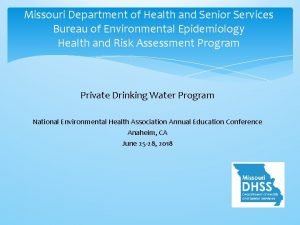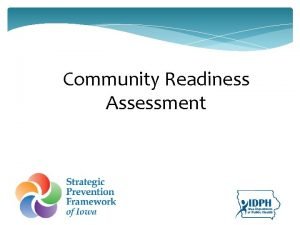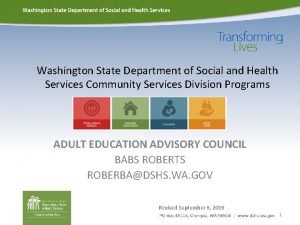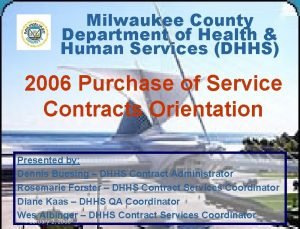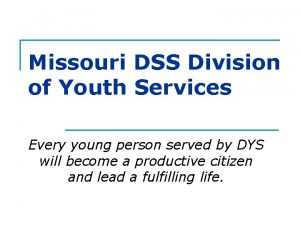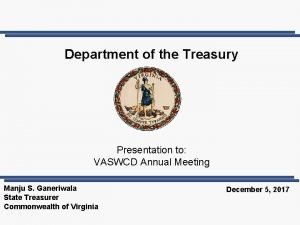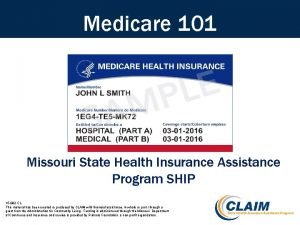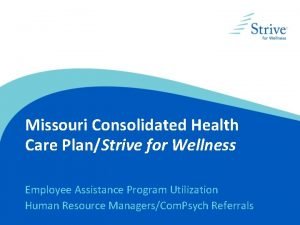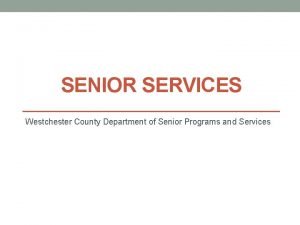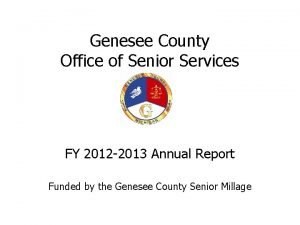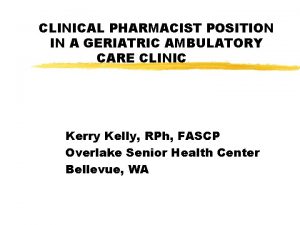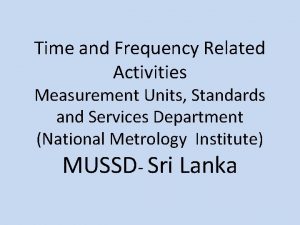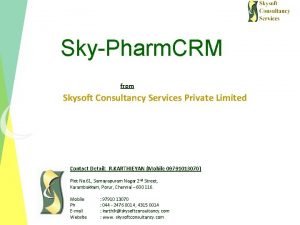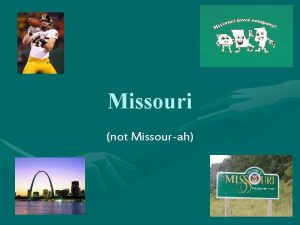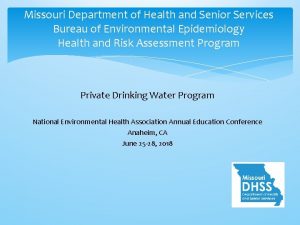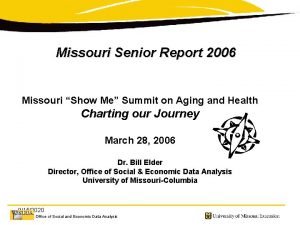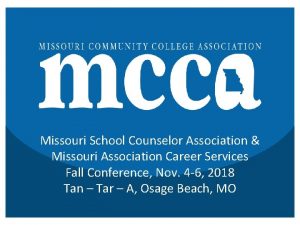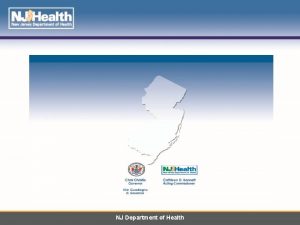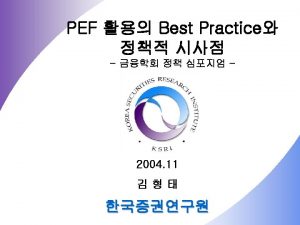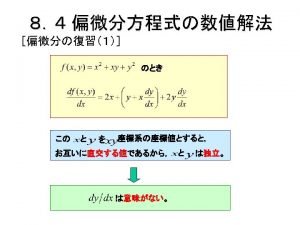Missouri Department of Health and Senior Services PRIVATE




















- Slides: 20

Missouri Department of Health and Senior Services PRIVATE DRINKING WATER PROGRAM ANNUAL UPDATE 2019

Highlights • The Missouri Department of Health and Senior Services (DHSS) Bureau of Environmental Epidemiology (BEE), the Bureau of Environmental Health Services (BEHS), and the Midwest Rural Community Assistance Program (RCAP) offered a one-day Private Drinking Water Training session to Local Public Health Agencies (LPHAs) in 12 locations across Missouri. • Creating a database and mapping contaminants.

BEHS Presentation

Introduction • Types of Water Supplies • Well Construction • Water Samples • Disinfection • Safety Considerations • Regulated Facilities • County Well Surveys

Surface Construction

Bad things

County-wide well surveys • Provide county-wide baseline of water quality and private well conditions. • Target a particular need or issue; such as changing land use patterns or disease prevalence. • Gather information to determine the need for new regulations; such as implementing a local on-site wastewater ordinance. • Identify knowledge or practice gaps. • Improve public health through education and assistance.

RCAP Presentation

Private Well Class Goals • Give well owners direct targeted information and advice: • Why their well is important, • Why they should understand how it works, • How to help protect themselves from risk. • Provide professionals working with private well owners resources and information to promote professional development.


Site Assessments • The U of I put together a national workgroup of experts from extension and public health; also groundwater hydrologists and drillers, to develop a tool to assess risk of an individual well. • Goal was to create a tool that can be used by an qualified health, groundwater or extension person to help a well owner understand their potential risks and vulnerabilities • • • Site assessment Well assessment Geologic assessment Recommendations Plus opportunity to raise awareness about testing, understanding vulnerable geologies or well construction

Exceptional Programs • Provide multi-model outreach to be sure well owners know about program. • Provide meaningful incentives. • Make it easy for the well owner to want to learn/sample/participate. • Demonstrate the value of the information being collected/shared/taught (why it should matter to the well owner). • Stick around, help solve problems, are a resource today and in 5 years to a well owner.

BEE Presentation

Learning Objectives • To be able to explain when and why to test. • To obtain a basic understanding of well water testing best practices and procedures. • Be able to collect and explain how to collect a good bacteria and chemistry sample. • To recognize the challenges in collecting good samples. • Know how to access private drinking water sample laboratory reports. • To know where to find information necessary for interpreting laboratory reports.

Bacteria water test options Coliform bacteria occur naturally in soil, on vegetation, and in surface waters such as lakes or streams. They also can be found in the intestines of humans and other animals. The majority of the coliform bacteria are not harmful and are used as an “indicator bacteria” in drinking water. If present, contamination of the water has occurred, and other disease causing bacteria may also have gotten into the water supply. Escherichia coli (E. coli) is a member of the coliform group of bacteria and is found only in humans and warm-blooded animals. E. coli in the drinking water indicates that it has been recently contaminated with human or animal wastes. Iron bacteria occur naturally in the soil and derive its energy by oxidizing iron, manganese or aluminum. This oxidizing process creates a reddish-brown slime which over time can build up, clogging screens, well pumps, faucets, pipes, tanks, etc. Iron bacteria are not harmful, but it does produce an unpleasant taste and odor. This test must be specifically requested.

Bacteria Water Sample collection Procedure 2. 1. Remove any screens or aeration devices that may be on your faucet. 3. Turn the hot water on full force and let it run for 3 minutes. Turn the hot water off and turn the cold water on and let it run for 3 minutes. Mix 1 1/2 tsp unscented bleach with one gallon of clean water and pour it into a spray bottle. It is very important that you use these exact measurements.

Chemistry water test options New Well Series ◦ p. H, fluoride, chloride, nitrate/nitrogen, sulfate, iron, manganese, and lead. Minerals, nutrients, and metals (MNM) ◦ p. H, fluoride, nitrate/nitrogen, chloride, sulfate, Total Dissolved Solids (TDS), iron, manganese, zinc, copper, lead, cadmium, chromium, cobalt, nickel, aluminum, arsenic, barium, mercury, lithium, beryllium, vanadium, molybdenum, antimony, thallium, thorium, uranium, strontium, tin, selenium, and titanium. EPA metals ◦ Beryllium, aluminum, chromium, iron, manganese, vanadium, cobalt, nickel, molybdenum, antimony, thorium, copper, zinc, arsenic, selenium, cadmium, antimony, barium, mercury, thallium, lead, and uranium.

Chemical water sample collection procedure 1. Open the container, being careful not to expose the lid to contamination from counter surfaces or splash during collection of the sample. If the container is not already expanded, carefully expand the container using your fingers by pulling on the back of the container; do not blow into or insert fingers into the container, as this will contaminate your sample.

Laboratory Report interpretation resources Environmental Protection Agency (EPA)◦ Primary Standards-research. net/index. php/standards/primary-standards ◦ Secondary Standardshttps: //www. waterresearch. net/index. php/standards/secondary-standards ◦ 2018 Edition of the Drinking Water Standards and Health Advisory Tableshttps: //www. epa. gov/sites/production/files/2018 -03/documents/dwtable 2018. pdf ◦ Water treatability databasehttps: //oaspub. epa. gov/tdb/pages/general/home. do https: //www. water

 Department of health and senior services missouri
Department of health and senior services missouri Iowa department of health and human services
Iowa department of health and human services Washington state department of social and health services
Washington state department of social and health services Milwaukee county department of health and human services
Milwaukee county department of health and human services Maine department of health and human services
Maine department of health and human services Dys missouri
Dys missouri Vaswcd
Vaswcd Louisiana health standards
Louisiana health standards Missouri state health insurance assistance program
Missouri state health insurance assistance program Missouri consolidated health care plan
Missouri consolidated health care plan Elder care services westchester county
Elder care services westchester county Genesee county office for the aging
Genesee county office for the aging Bernalillo senior center
Bernalillo senior center Overlake anticoagulation clinic
Overlake anticoagulation clinic Senior health clinic
Senior health clinic Florida dept of agriculture and consumer services
Florida dept of agriculture and consumer services Virginia department of agriculture food safety
Virginia department of agriculture food safety Measurement units standards and services department
Measurement units standards and services department Pharma crm consultants
Pharma crm consultants Oracle private cloud infrastructure
Oracle private cloud infrastructure Join hands marine
Join hands marine
